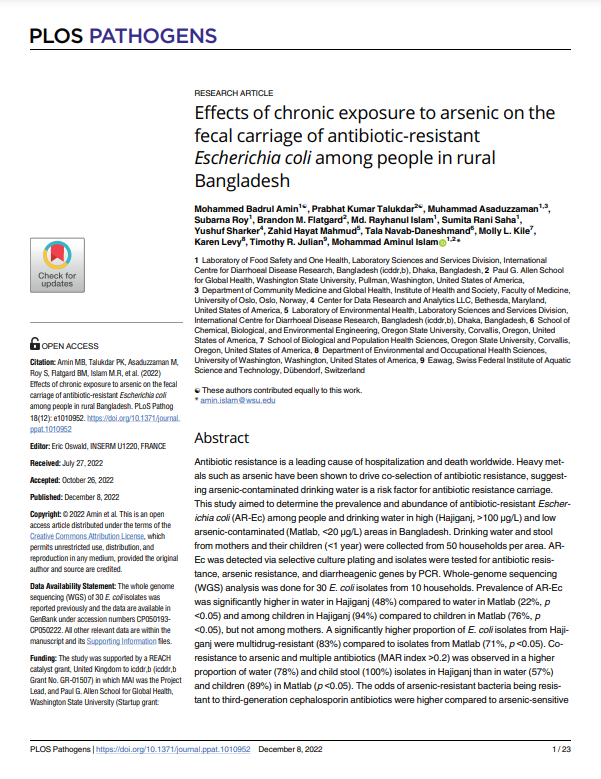Mohammed Badrul Amin, Prabhat Kumar Talukdar, Muhammad Asaduzzaman, Subarna Roy, Brandon M. Flatgard, Md. Rayhanul Islam, Sumita Rani Saha , Yushuf Sharker, Zahid Hayat Mahmud, Tala Navab-Daneshmand, Molly L. Kile, Karen Levy , Timothy R. Julian, Mohammad Aminul Islam
Antibiotic resistance is a leading cause of hospitalization and death worldwide. Heavy metals such as arsenic have been shown to drive co-selection of antibiotic resistance, suggesting arsenic-contaminated drinking water is a risk factor for antibiotic resistance carriage. This study aimed to determine the prevalence and abundance of antibiotic-resistant Escherichia coli (AR-Ec) among people and drinking water in high (Hajiganj, >100 μg/L) and low arsenic-contaminated (Matlab, <20 μg/L) areas in Bangladesh. Drinking water and stool from mothers and their children (<1 year) were collected from 50 households per area. AREc was detected via selective culture plating and isolates were tested for antibiotic resistance, arsenic resistance, and diarrheagenic genes by PCR. Whole-genome sequencing (WGS) analysis was done for 30 E. coli isolates from 10 households. Prevalence of AR-Ec was significantly higher in water in Hajiganj (48%) compared to water in Matlab (22%, p <0.05) and among children in Hajiganj (94%) compared to children in Matlab (76%, p <0.05), but not among mothers. A significantly higher proportion of E. coli isolates from Hajiganj were multidrug-resistant (83%) compared to isolates from Matlab (71%, p <0.05). Coresistance to arsenic and multiple antibiotics (MAR index >0.2) was observed in a higher proportion of water (78%) and child stool (100%) isolates in Hajiganj than in water (57%) and children (89%) in Matlab (p <0.05). The odds of arsenic-resistant bacteria being resistant to third-generation cephalosporin antibiotics were higher compared to arsenic-sensitive bacteria (odds ratios, OR 1.2–7.0, p <0.01). WGS-based phylogenetic analysis of E. coli isolates did not reveal any clustering based on arsenic exposure and no significant difference in resistome was found among the isolates between the two areas. The positive association detected between arsenic exposure and antibiotic resistance carriage among children in arsenic-affected areas in Bangladesh is an important public health concern that warrants redoubling efforts to reduce arsenic exposure.

